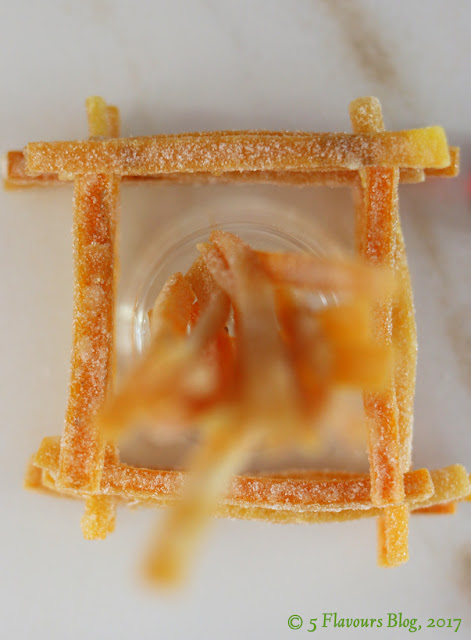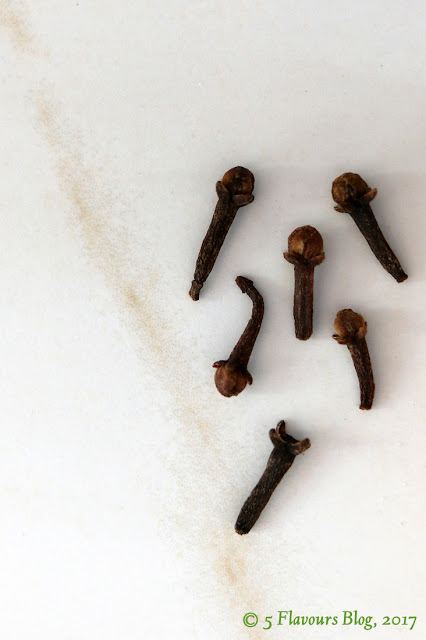Candied Orange Peel
Elevating Humbleness ...
– JUMP TO RECIPE –
– PRINT RECIPE –
Candied fruit have been around for a very long time, since the 14th century in fact. The technique was originally used for preserving fruit that spoil easily. Today we also use this ancient and simple procedure to concentrate and amplify the citrus flavour and taste of oranges for wide application in the culinary world.
The number of applications for candied orange peel are truly legion.
Traditionally, candied fruit (also known as crystallized or glacé fruit) was used primarily in baked
goods, desserts and cool drinks & cocktails. Yet times they are a changing.
In later posts we’ll investigate the application of orange peel to savoury
dishes as well, in particular: their use in Cooking The Dark Side ...
There are a number of methods to candy whole fruit, fruit sections or
parts of fruit. Preparation times vary from fairly quick to extended over many
days. In this modern, fast paced world we don’t have that luxury – tempus fugit! In this post we use a
simple syrup (1:1 water to sugar) to preserve the fruit peel only.
There are two main methods for removing sections of peel from citrus
fruit:
- Cutting the fruit into sections, removing the flesh and trimming excess, flavour ‘diluting’ pith as necessary, or
- Using a vegetable peeler to ‘shave’ whole strips from the outer surface of the fruit, thus eliminating the need to section the fruit and trim excessive pith.
I find the first method to yield a superior end product. Granted, it
requires an entry level of knife skill to pare away any excessive white pith,
but the final product is well worth the extra effort in terms of taste, texture
and colour. Retaining a small quantity of pith acts as both a moisture
reservoir and sponge during the poaching and cooking process of the peel. The
extra moisture in the pith prevents the peel from cooking too fast during
poaching and afterwards, during drying, retains some moisture resulting in a
softer, more pliable product. Anyway, after decades of selective horticulture,
the pith of modern citrus fruit is not nearly as thick nor bitter (and undesirable)
as the fruit our grand parents had to contend with.
‘Shaving’ orange peel from the fruit’s surface with a vegetable peeler
leaves very little absorbent material (white pith) underneath the outer layer
of skin. In my experience, the dehydrating nature of poaching the shaved peel
in syrup not only cooks and desiccates it excessively, but hardens and toughens
it excessively as well. Subsequently the chopped peel takes longer to rehydrate
and soften during the baking of cakes or sweet rolls, often surprising the
consumer with unexpected shards of tough, chewy peel. Not nice at all.
As a final note aside: reserve the left over poaching syrup and use it
over fruit salad or baked desserts, or dilute it with ice cold water for a refreshing cool
drink on a hot day. For the daring, adventurous spirits out there: add a dash
of orange syrup to your first cup of Wiener Mischung for a surprising effect.
Recipe yields:
± 250 ml
|
Total preparation time:
± 1 Day
|
Difficulty level:
Easy peasy!
|
Special Equipment Required:
1
x Wire cooling rack
1
x Thin bladed filleting knife or medium sized, thin bladed kitchen utility
knife, shaving sharp
Ingredients:
Navel oranges, washed and
dried
|
5
|
Water
|
250ml
|
White sugar
|
250g
|
Whole, dried cloves
|
3
|
Caster sugar to coat the
strips of candied peel
|
Method:
- Divide each fruit into 8 sections:
Trim enough peel from the top and bottom of each orange to fully expose the flesh. Cut each fruit in half from top to bottom. Cut each half evenly into quarters, length wise. Carefully slice each quarter in half, length wise. - Remove the flesh and trim the pith:
Place each orange section peel side down on a dry cutting board. Remove the fruit section with the utility knife using gentle to and fro slicing motions. Press the wedge of peel, skin side down, flat on the cutting board using the thumb and index finger from one hand. Place the filleting knife flat on the pith near the thumb. Keeping the blade level and at a very shallow entry angle, slowly slice into the pith towards the index finger in one firm motion. Turn the section of peel around and repeat on the part still retaining excess pith. Discard the trimmed pith. Cut the sections of trimmed peel into strips of desired width. - Crystallize the peel:
Combine the water, sugar and cloves in a sauce pan over medium heat. Stir and heat until the sugar dissolves. Add the strips of peel and heat until the syrup starts to boil. Reduce the heat until the syrup simmers gently. Partially cover the pan and simmer – with frequent stirring – until the orange peel strips turn translucent and become soft, approximately 45 – 60 minutes, depending on the thickness of the strips. - Remove the candied peel with a slotted spoon and transfer to the wire cooling rack (placed in a suitable container to collect the dripping syrup). Arrange the strips into a single layer and set aside to drain and dry over night. Separate the individual strips to prevent sticking and clumping later on.
- Transfer the dried strips onto a sheet of waxed paper and liberally sift caster sugar over. Shake the sheet to ensure the each strip of candied peel is thoroughly covered. Collect the sugared, candied peel into an airtight container, add an extra dessert spoon of caster sugar, seal and store in a cool, dark place.
- Cool the poaching syrup, remove and discard the cloves and bottle the cooled syrup for later re-use or other applications.
Comments:
- Thin bladed, shaving sharp knives are essential for successfully separating the fruit segments from the peel of the orange fruit wedges and subsequently trimming away any excess white pith, if necessary. Trimming excess pith requires a gentle, yet steady hand to avoid slicing too far into the pith and mangling the orange peel wedges.
- The freshly candied strips of orange peel may take longer than over night to dry completely, depending on ambient temperature and humidity. Dry the strips in a very low oven or warming drawer if the weather is rainy or the kitchen is on the coast.
- Keep an eye on the consistency of the simmering syrup. Fully covering the pan will cause the syrup to eventually boil over and turn the stove top into a sticky, sweet disaster zone. Fully uncovering the pan allows too much water evaporation and will quickly reduce the syrup to soft ball stage and beyond. This is undesirable as the too high temperature will eventually harden and darken the poaching strips, negatively affecting taste and texture. Add table spoons of hot water to the simmering syrup as deemed necessary.
- This method also works particularly well for crystallizing lemon peel.
© RS Young, 2017
– RECIPE INDEX PAGE –
Follow Me on Facebook
Note:
Post
updated on 2024.03.18 to include:
1.
The updated Recipe for downloading as a PDF file, and
2.
Recipe Title and Print Recipe, Recipe Index and Facebook & Pinterest follow
links.








Comments
Post a Comment